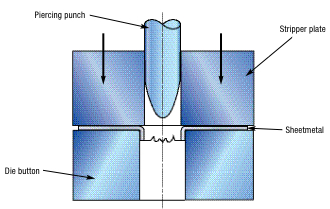Tool and die makers are at the top of the ladder in the metalworking trades. They are very versatile in using their hands for creating parts as well as machines to produce high precision parts. Their abilities go beyond that of the typical machinist. They are capable of designing and fabricating tools with no supervision. With these skills, tool and die makers are a tremendous asset in any manufacturing facility.
Master basic math. Understand addition, subtraction, and division. A little shop trigonometry is good for calculating bolt circles and finding the length of triangles. Some basic algebra can also be handy for applying handbook formulas.
Learn computer drafting. Suitable skills are included in vocational and technical schools' machining programs. Learn to create and interpret mechanical drawings.
Enter an apprenticeship program at a tool and die shop while in high school if possible. As an apprentice, you will do simple tasks like drilling, deburring, and sweeping in the beginning. The tasks will become more challenging as time goes on. You will learn the lathe, mill and surface grinder. Apprenticeships typically last 2 to 4 years.
Study machine tool technology at a good vocational trade school. Programs vary from school to school. Make sure you are studying at one that has various machines to learn from. A wire EDM (electrostatic discharge machining) tool would be nice. Also, make sure they have good CNC (computer numerically controlled) programming courses. Try to get hands-on experience in a shop rather than studying only in a classroom. The heart of your education will be in the types of projects you will be making in the course. A typical machine tool technology program will last two years.
Get a copy of the Machinery Handbook and refer to it often. This is an excellent reference for answering any machining problem.
Buy a set of good high quality precision tools like 1-2-3 inch micrometers, and a square set, along with a 7- or 11-drawer machinists toolbox. An electronic caliper is a plus also.
Try to stay away from generic tools because these seem to be less durable. Instead, invest in high quality tools like Starrett and Mitutoyo, top names in the trade.
If money is tight, obtain tools gradually, as you need them, over time, until you have your own set. Get the ones you need most first.
Try to stay away from generic tools because these seem to be less durable. Instead, invest in high quality tools like Starrett and Mitutoyo, top names in the trade.
If money is tight, obtain tools gradually, as you need them, over time, until you have your own set. Get the ones you need most first.
If you want to further your career in the tool and die trade, you may want to move into supervision or teaching. A Bachelor's degree in almost any field along with tool and die experience would be very beneficial in obtaining a supervisor's job in manufacturing and/or teaching.


















